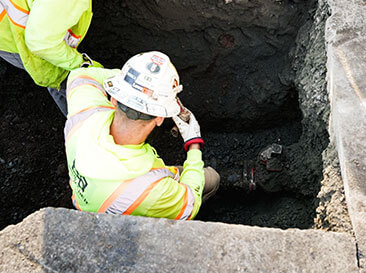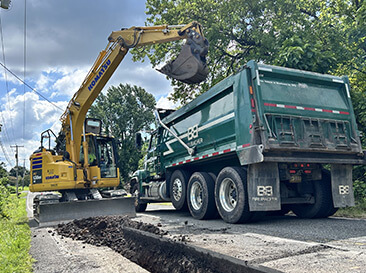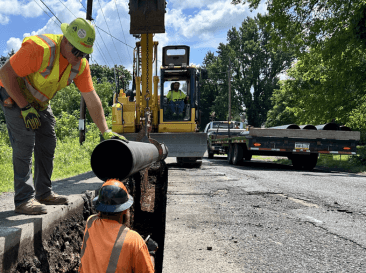Lead & Galvanized Service‑Line Replacement
Your Top Questions Answered
Federal and Pennsylvania mandates now require every water system to locate and replace aging lead service lines—and certain galvanized lines that can accumulate lead—within a decade. Below, you’ll find straightforward answers to the questions we often hear from municipal and private‑system leaders, as well as uncommonly refreshing solutions from Brubacher to make becoming compliant as seamless as possible.
1. What does the EPA’s Lead & Copper Rule Improvements (LCRI) actually require?
In October 2024, the U.S. EPA finalized the Lead & Copper Rule Improvements (LCRI), giving most water systems 10 years (until the end of 2034) to locate and fully replace all lead and certain galvanized service lines that can leach or trap lead. The LCRI additionally seeks to improve communication within communities so that families are better informed about the risk of lead in drinking water, the location of lead pipes, and plans for replacing them. Full information about the rule improvements can be found on the EPA’s website here.
2. How do Pennsylvania regulations change the picture?
One key point to remember is that many states, including Pennsylvania, have been setting tighter schedules and extra reporting requirements. Failing to act risks fines, loss of available funding, and—most importantly—public trust. Here in the Commonwealth, the Public Utilities Commission is the source of additional regulations.
Fast Facts about Lead Service Line Response in PA
- Act 120 (2018) lets PA utilities replace customer-owned lead lines and recover costs through rates, enabling full-length replacements.
- PA PUC regulations state that utilities must submit Lead Service Line Replacement (LSLR) program petitions that meet specific timelines and reporting rules.
- Many organizations have already initiated programs to achieve annual replacement goals to meet the 2034 deadline.
3. How widespread are lead and galvanized service lines here in Pennsylvania?
The EPA estimates that there are approximately 689,000 lead service lines (LSL) statewide—about 7.5% of all service connections—giving Pennsylvania the fourth‑highest total in the country after Florida, Illinois, and Ohio.
4. Why are galvanized service lines on the replacement list if they contain no lead?
Galvanized steel’s ridged interior can trap lead particles shed from upstream lead pipes. Hydraulic shocks or water‑chemistry changes later flush that lead back into finished water, so the EPA treats these lines as the same public health risk as pure‑lead piping.
5. What do we do if our system’s records are incomplete or outdated?
Having incomplete records of your system’s lead and galvanized pipe inventory is not uncommon, especially here in Pennsylvania where some systems are 100+ years old and were added to over the course of decades. You can work to create an inventory on your own, but we strongly suggest you consider working with a knowledgeable resource to both speed up the process and ensure that the survey and reporting work is verified.
With experience and adaptability you can count on, the Brubacher Utilities team is that knowledgeable resource ready to perform all lead and galvanized service-line management tasks quickly, economically, and, most importantly, safely.
We start with a Vac Ex curb-to-meter survey, which includes:
- Securing 811 tickets, traffic control, and resident notices.
- Vacuum excavation of curb stops or other targeted points.
- Recording of depth, diameter, and material with HD photos.
- Delivery of a GIS-ready PDF inventory and a prioritized map for replacements.
The result is a defensible, audit-ready dataset that removes any guesswork and gaps in information.
6. Once we have an inventory in hand, what are the next steps?
Planning and permitting will be the next phase, which would include securing any federal or state-level funding for the replacement project. You will need to scope your whole system or targeted geographic areas (like city blocks) where replacements need to occur and obtain highway occupancy permits as part of this effort.
This can be incredibly time-consuming, especially for smaller private system operators, which is why we’ve designed a three-phase process to help.
Survey & Report → Plan & Permit → Replace & Restore—all under one COSTARS eligible, PennDOT pre-qualified contract. You’ll work directly with our Utilities team, backed by industry-leading vacuum excavation and trenchless crews, and in partnership with licensed plumbers.
7. Will replacements tear up streets and yards?
Our process is designed to minimize disruption. Brubacher is here to help you get ahead of the mandates without altering daily life for your customers. Our crews use trenchless pull‑through methods (pneumatic “gopher” or core drill) whenever possible. That typically means one entry hole at the curb, one at the basement wall, and same‑day lawn restoration. We self-perform asphalt restoration for mains or services in public roadways, so no separate paving contractor slows the reopening.
8. How do you coordinate with residents, especially when service line ownership is shared?
We offer customized services for joint ownership solutions. Whether your agency covers main-to-curb only or full-service line to the meter, Pennsylvania’s Act 120 encourages utilities to replace the private side, which means additional homeowner/property owner coordination and scheduling. We:
- Can help you provide communications pre‑ and post‑work.
- Assign a single project liaison residents can call for real‑time updates.
Regardless of whether your policy stops at the curb or extends to the meter, we tailor the scope and keep everyone informed.
At Brubacher, we take seriously our role as guests in communities and neighborhoods. We prioritize public safety and work hard to maximize efficiency and minimize disruptions to deliver a positive, uncommonly refreshing experience to every individual we come into contact with throughout the project.
Are you ready to move from mandate to action, or have more questions?
Get in touch with our team today. We’ll review your current records, outline a fixed‑fee proposal, and set a replacement schedule that keeps your water system ahead of the 10‑year compliance countdown clock.




